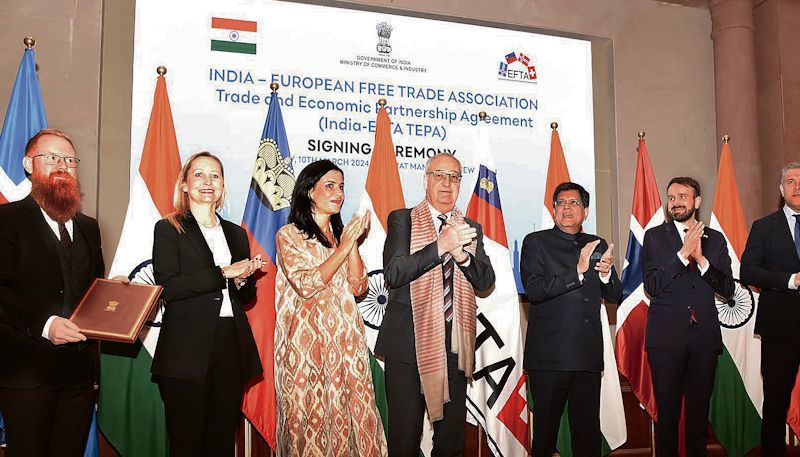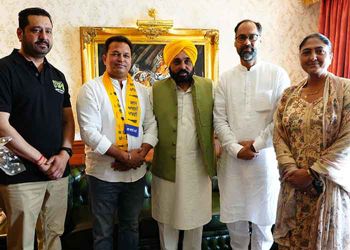
Need of the hour: The agreement with the EFTA as well as the ones in the pipeline are essential to meet the challenge of the global economic downturn. ANI
Sushma Ramachandran
Senior Financial Journalist
INDIA’S share of global trade is currently only about two per cent in contrast to 14 per cent for our northern neighbour, China. The country has so far not been able to become a major trading nation in the merchandise segment, though services exports in contrast are growing at a swift pace. The situation is not helped by the fact that we are not part of any major regional trade grouping. The decision to stay away from the Regional Comprehensive Economic Partnership stemmed from a fear of being overrun by imports from China. But it has not been possible to make up this lacuna by merging into any of the overarching larger groups like the Trans-Pacific Partnership.
EFTA members have pledged to provide $100 billion of investment to India over the next 15 years.
It is in this backdrop that one must view the drive to tie up more regional and bilateral trade pacts. After concluding major agreements with leading trade partners like the UAE, Australia and Mauritius, a deal has now been struck with the four-member European Free Trade Association (EFTA). Others are being negotiated, including one with the country’s biggest trade partner, the European Union (EU), the UK and Oman. There are also reports of discussions with the Gulf Cooperation Council comprising seven countries in the region.
The fact that such talks are now proceeding apace indicates the country’s increasing clout on the world stage as its concerns over protecting domestic interests are being given more thoughtful consideration by trading partners. The previous intractable approach in negotiations taken by the country’s trade diplomats also seems to have been replaced by an appreciation of the larger picture. The fact is that allowing foreign business to have easier access to the domestic market will similarly ensure deeper access for Indian agriculture and industry to the lucrative developed economy markets. It has also been accepted that issues like sustainability, which were earlier dismissed as non-trade barriers, should be brought on board.
It is clearly the difference in approach on both sides that is leading to a much quicker conclusion of such pacts. In the case of the India-EFTA agreement, talks had originally been launched as far back as 2008, but they were called off in 2013. It took another decade for them to resume in 2023. The pact has now become a reality within a year. Similarly, negotiations with the country’s largest trading partner, the EU, began in 2007 but were suspended in 2013. These were revived in 2022.
With elections round the corner, it looks as if agreements with both the EU and the UK will have to await the formation of a new government. The tie-up with the EFTA, however, has been made in time to ensure that the benefits are available by next year. This particular one did not initially attract much attention, given the few countries in the grouping. This is unlike the one with the EU, which has been under much greater scrutiny. The EFTA, on the other hand, comprises only Switzerland, Norway, Iceland and the tiny principality of Liechtenstein, with two-way trade estimated at $18 billion. The biggest trade partner of India in the group is Switzerland and the bulk of transactions with it comprise gold imports.
Yet, it must not be forgotten that this relatively small country is a major global financial and business hub. Apart from its legendary banking system, it is known for its pharmaceuticals and dairy production. It is also, in a sense, a window to Europe.
Thus, the opening up of as many as 120 out of the 156 services in the pact will give a boost to Indian professionals in the IT and financial sectors. Significantly, services exports to EFTA countries are about $5 billion annually, as compared to $2 billion of merchandise exports. In contrast, India is not likely to benefit much from the pact in terms of tariffs as Switzerland has just announced the abolition of import duties on industrial goods from all over the world. Effectively, this means that India will have no advantage over other countries in terms of tariffs on its exports.
Even so, the trade pact has become path-breaking for including investment commitments. EFTA members have pledged to provide $100 billion of investment over the next 15 years to India. This will be facilitated by the concerned governments but will have to come from private companies.
A disappointing aspect of the investment plan is the exclusion of sovereign wealth funds from the commitments. Their exclusion will mean there is little certainty of investment growth up to the target of $100 billion. There is also an expectation that these investments will result in the creation of one million jobs, but only in case of the investments becoming a reality.
The India-EFTA trade agreement is, thus, not an ideal document, but it is certainly indicative of some innovative solutions to ensure that India is able to benefit from opening up its markets. As expected, there was pressure on this country to relax its rules on the issue of patents, given the presence of big pharma in Switzerland. Initial reports indicate that there was no easing of the current rules on intellectual property rights as laid down by the World Trade Organisation, though there have been genuine concerns on this score.
On the European side, the impetus to push forward with the deal has much to do with the change in the geopolitical situation in recent years. There is greater interest now to support infrastructure development in this country as a counterbalance to China. The Indian side is also keener on bilateral trade arrangements than ever before, especially with recessionary conditions sweeping the world. The agreement with the EFTA as well as the ones in the pipeline are essential to meet the challenge of the global economic downturn. But the task of stitching up such pacts should have been taken up much earlier to give a competitive edge to India’s exports in the face of the fast-changing geopolitical situation.
Join Whatsapp Channel of The Tribune for latest updates.




























